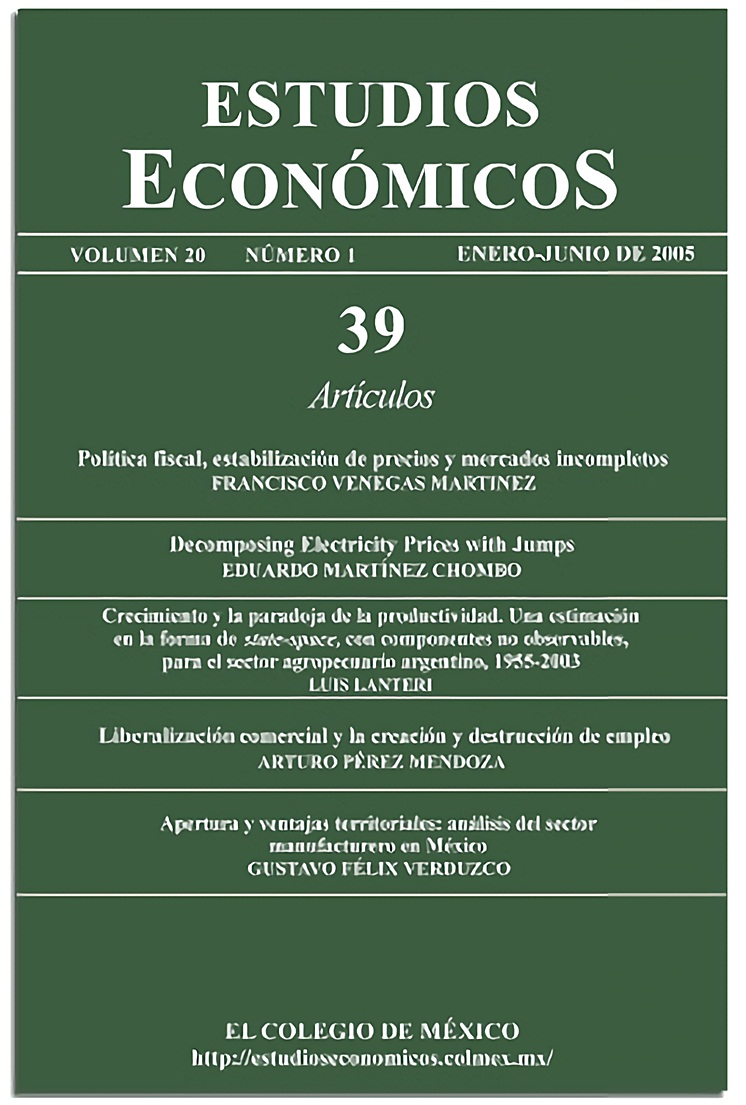Crecimiento y la paradoja de la productividad. Una estimación en la forma de state-space, con componentes no observables, para el sector agropecuario argentino, 1955-2003
Publicado 2005-01-01
Palabras clave
- precios de electricidad,
- finanzas de energía,
- representación estado-espacio
Cómo citar
Resumen
Se realizan estimaciones de la productividad total de los factores para el sector agropecuario argentino de 1955 a 2003. Algunos trabajos muestran que los índices Divisia, utilizados para medir el crecimiento de la productividad, proporcionarían estimaciones poco confiables de este indicador cuando el cambio tecnológico no es neutral en el sentido de Hicks, dado que, en ese caso, las participaciones de los factores en el costo combinarían las contribuciones de los factores al crecimiento del producto con el cambio tecnológico. A tal efecto, se estima en el trabajo el sesgo del cambio tecnológico, a través de un sistema de funciones de participación en el costo, planteadas en la forma de espacio-estado (state-space) con componentes no observables para poder construir un índice Divisia con tecnología constante y ajustar la estimación de la productividad total de los factores.
Descargas
Citas
- Ahearn, M. et al. (1998). Agricultural Productivity in the US, Agricultural Information Bulletin, núm. 740, USDA, Washington.
- Archibald, S. y L. Brandt (1991). A Flexible Model of Factor Biased and Technological Change: An Application to Japanese Agriculture, Journal of Development Economics, (35), 127-145.
- Arnade, C. (1997). Using a Programming Approach to Measure International Agricultural Efficiency and Productivity, Journal of Agricultural Economics, (49), 67-84.
- Bailey, A., K. Balcombe y J. Morrison (2001). Modelling Technical Change Biases: A Comparison of Proxy Variable and Stochastic Latent Variable Approaches to the Measurement of Technology Biases in South African Agriculture, (mimeo).
- Balcombe, K. et al (2000). Stochastic Biases in Technical Change in South African Agriculture, Agrekon, (39), diciembre.
- Balcombe, K., X. Irz y A. Bailey (2003). An Application of the Stochastic Latent Variable Approach to the Correction of Sector Level TFP Calculations in the Face of Biased Technological Change, (mimeo).
- Binswanger H. (1978). Measured Biases of Technical Change: The US, en H. Binswanger y V. Ruttan (comps.), Induced Innovation, Technology, Institutions and Development, Johns Hopkins University Press.
- Binswanger H. (1974a). The Measurement of Technical Change Biases with Many Factors of Production, American Economic Review, (64), diciembre.
- Binswanger H. (1974b). A Cost Function Approach to the Measurement of Elasticities of Factor Demand and Elasticities of Substitution, American Journal of Agricultural Economics, (56), 377-386.
- Blackorby, C. y R. Russell (1989). Will the Real Elasticity of Substitution Please Stand Up? A comparison of the Allen-Uzawa and Morishima Elasticities, American Economic Review, (79), 882-888.
- Chambers, R. (1988). Applied Production Analysis: A Dual Approach, Cambridge University Press.
- Clark, S. y C. Youngblood (1992). Estimating Duality Models with Biased Technical Change: A Time Series Approach, American Journal of Agricultural Economics, (74), 353-360.
- Elias, V. (1985). Government Expenditures on Agriculture and Agricultural Growth in Latin America, IFPRI núm. 50, International Food Policy Research Institute, Washington.
- Esposti, R. y P. Pierani (1997). The Source of Technical Change in Italian Agriculture: A Latent Variable Approach, University of Wisconsin-Madison.
- Felipe, J. y J. McCombie (2001). Biased Technical Change, Growth Accounting and the Conumdrum of the East Asian Miracle, Journal of Comparative Economics, (29), 542-565.
- Ferguson, Ch. (1968). Neoclassical Theory of Technical Progress and Relative Factor Shares, Southern Economic Journal, (34), 490-540.
- Ferguson, Ch. y J. Moroney (1969). The Sources of Change in Labors Relative Share: A Neoclassical Analysis, Southern Economic Journal, (35), 308-322.
- Fulginiti, L. y P. Perrin (1999). Have Price Policies Damaged LDC Agricultural Productivity? Contemporany Economic Policy, (17), 469-475.
- Fulginiti, L. y P. Perrin (1997). LDC Agriculture: Non-parametric Productivity Indexes, Journal of Development Economics, (58), 373-390.
- Hayami, Y. y V. Ruttan (1985). Agricultural Development: An International Perspective, 2da. ed., Johns Hopkins University Press.
- Hicks, J. (1932). The Theory of Wages, 1a. ed., Macmillan.
- Hsieh Chang-Tai (2000). Measuring Biased Technology, Princeton University, http://www.wws.princeton.edu/chsieh/DIVISIA4.pdf.
- Huang, K. (1991). Factor Demands in the US Food-Manufacturing Industry, American Journal of Agricultural Economics, (73), 615-620.
- Hulten, Ch. (1973). Divisia Index Numbers, Econometrica, (41), 1017-1025.
- Kohli, U. (1994). Technological Biases in US Aggregate Production, Journal of Productivity Analysis, (5), 5-22.
- Lambert, D. y J. Shonkwiler (1995). Factor Bias under Stochastic Technical Change, American Journal of Agricultural Economics, (77), 578-590.
- Leontief, W. (1947). Introduction to the Theory of the Internal Structure of Functional Relationship, Econometrica, (15), 361-373.
- Leontief, W. (1943). A Note on the Interrelation of Subsets of Independient Variables of a Continuous Function with Continuous Partial Derivatives, Bulletin of the American Mathematical Society, (53), 343-350.
- Lim, H. y R. Shumway (1997). Technical Change and Model Specification: US Agricultural Production, American Journal of Agricultural Economics, (79).
- Mundlak, Y. y R. Domenech (1986). Estadísticas de la evolución económica de la Argentina, 1913-1984, Estudios, julio-septiembre.
- Murgai, R. (2001). The Green Revolution and the Productivity Paradox: Evidence from the Indian Punjab, Agricultural Economics, (25), 199-209.
- Nelson, R. y H. Pack (1999). The Asian Miracle and Modern Growth Theory, The Economic Journal, (109), 416-436.
- Nghiep, L. T. (1979). The Structure and Changes of Technology in Prewar Japanese Agriculture, American Journal of Agricultural Economics, (61), 687-692.
- Olmstead, A. y P. Rhodes (1993). Induced Innovation in American Agriculture: A Reconsideration, Journal of Political Economy, (101), 100-118.
- Rodrik, D. (1997). TFP Controversies, Institutions and Economic Performance in East Asia, NBER, WP, 5914.
- Ruttan, V. (2002). Productivity Growth in World Agriculture: sources and Constraints, Journal of Economic Perspectives, (16), 161-184.
- Sharma, S. (2002). The Morishima Elasticity of Substitution for the Variable Profit Function and the Demand for Imports in the United States, International Economic Review, (43), febrero.
- Solow, R. (1957). Technical Change and the Aggregate Production Function, Review of Economics and Statistics, (39), 312-320.
- Stevenson, R. (1980). Measuring Technological Bias, American Economic Review, (70), 162-173.
- Trueblood, M. y J. Coggins (2001). Intercountry Agricultural Efficiency and Productivity, (mimeo).

